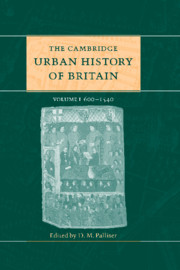Book contents
- Frontmatter
- Part I Introductory
- Part II The early middle ages 600–1300
- Part III The later middle ages 1300–1540
- Part IV Regional surveys
- 21 Regional introduction (England and Wales)
- 22(a) The South-East of England
- (b) The South-West of England
- (c) The Midlands
- (d) East Anglia
- (e) Northern towns
- (f) Wales and the Marches
- 23 Scotland
- Part V Conclusion
- Appendix: Ranking lists of English medieval towns
- Select bibliography
- Index
- References
(e) - Northern towns
from 22(a) - The South-East of England
Published online by Cambridge University Press: 28 March 2008
- Frontmatter
- Part I Introductory
- Part II The early middle ages 600–1300
- Part III The later middle ages 1300–1540
- Part IV Regional surveys
- 21 Regional introduction (England and Wales)
- 22(a) The South-East of England
- (b) The South-West of England
- (c) The Midlands
- (d) East Anglia
- (e) Northern towns
- (f) Wales and the Marches
- 23 Scotland
- Part V Conclusion
- Appendix: Ranking lists of English medieval towns
- Select bibliography
- Index
- References
Summary
the nature of the region
The pace and pattern of urbanisation in northern England was more varied than the traditional image of an undeveloped backwater might suggest (Map 22.11). Certainly this is an area with a high proportion of upland over 500 feet (180m) and large tracts of uncultivated marginal land where economic activity was invariably measured lower than in other English regions. Yet, within a region divided north–south by the spine of the Pennines and east–west by the Lakeland massif and North Yorkshire Moors, the dominant characteristic of northern settlement history was its variety.
Both coasts are penetrated by navigable rivers draining large basins. The resultant landforms created different soil types which changed over comparatively short distances, to include thin sands and gravels, acid moorlands, estuarine fens, alluvial flood plains, the inland mosses of Lancashire and Cheshire and the well-drained eastern lowlands. The difficult terrain dictated land communications. These had been established by the Romans and survived for the most part as the only routes feasible: north–south on either side of the Pennines following lowland plains and valley routes (Eden–Lune), trans-Pennine across the south Pennines from Tadcaster to Chester via Manchester, north-west from upper Teesdale across Stainmore to the Solway, and west along Hadrian's wall.
- Type
- Chapter
- Information
- The Cambridge Urban History of Britain , pp. 657 - 680Publisher: Cambridge University PressPrint publication year: 2000
References
- 2
- Cited by



